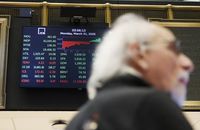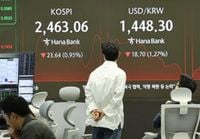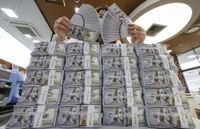On April 4, 2025, the won-dollar exchange rate in the Seoul foreign exchange market experienced significant fluctuations, closing at 1452.3 won, a drop of 14.7 won from the previous day's closing price. The exchange rate opened at 1450.5 won, initially declining by 16.5 won before hitting a low of 1448.5 won, before slightly rebounding. This decline is largely attributed to the shockwaves sent through global financial markets following the announcement of reciprocal tariffs by U.S. President Donald Trump.
On April 3, 2025, the New York Stock Exchange saw dramatic losses, with the Dow Jones Industrial Average closing down 1679.39 points (-3.98%) at 4545.93. The S&P 500 index fell 274.45 points (-4.84%) to 5396.52, and the Nasdaq Composite Index plummeted 1050.44 points (-5.97%) to 16550.61. These drops marked the largest daily declines for both the Dow and S&P 500 since June 2020, while the Nasdaq experienced its largest drop since March 2020.
The S&P 500 index has now fallen approximately 12% from its high in February, reaching a low not seen since Trump's election victory in November of the previous year. In total, about $3.01 trillion in market capitalization evaporated in just one day, highlighting the severe impact of Trump's tariff announcement.
Companies with production bases outside the U.S. were particularly hard hit. Nike's stock fell by 14.44%, while discount retailer Five Below saw a staggering drop of 27.81%. Other clothing brands, including Gap, reported a drop of 20.29%. Major technology stocks also suffered, with Apple experiencing its largest decline in five years, dropping 9.25%. Analysts noted that more than 80% of Apple products are manufactured in Asia, including China, which is a primary target of the new tariffs. Apple's market capitalization decreased by $311 billion, barely maintaining its value above $3 trillion.
Moreover, other major tech stocks, collectively referred to as the 'Magnificent Seven', also faced significant declines. Amazon's stock fell by 8.98%, Meta by 8.96%, Nvidia by 7.81%, Tesla by 5.47%, Alphabet by 4.02%, and Microsoft by 2.36%. The dollar also weakened considerably, with the dollar index, which measures the dollar's value against six major currencies, falling by 2.2% to 101.53. This drop reflects growing concerns about the economic repercussions of the U.S.'s protectionist measures.
As the day progressed, the won-dollar exchange rate continued to show volatility. By mid-morning, the rate had fallen to 1439.9 won, marking a notable decline linked to the ongoing effects of Trump's trade policies. The market is now bracing for potential further volatility, especially with the Constitutional Court's deliberation on President Yoon's tax cut scheduled for later in the day.
Market analysts are closely monitoring the situation, as the outcome of this deliberation could have significant implications for the exchange rate and overall market stability. The uncertainty surrounding both the U.S. tariffs and domestic political developments is creating a complex environment for investors.
In summary, the ripple effects of Trump's tariff announcement have not only impacted U.S. markets but are also reverberating through the global economy, particularly in South Korea. As the won-dollar exchange rate fluctuates amid this uncertainty, investors remain cautious, watching for any signs of stabilization or further decline. The situation underscores the interconnectedness of global markets and the far-reaching impacts of political decisions.







